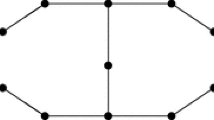Abstract
We show that one can formulate an algebra with lattice ordering so as to contain one quantum and five classical operations as opposed to the standard formulation of the Hilbert space subspace algebra. The standard orthomodular lattice is embeddable into the algebra. To obtain this result we devised algorithms and computer programs for obtaining expressions of all quantum and classical operations within an orthomodular lattice in terms of each other, many of which are presented in the paper. For quantum disjunction and conjunction we prove their associativity in an orthomodular lattice for any triple in which one of the elements commutes with the other two and their distributivity for any triple in which a particular element commutes with the other two. We also prove that the distributivity of symmetric identity holds in Hilbert space, although whether or not it holds in all orthomodular lattices remains an open problem, as it does not fail in any of over 50 million Greechie diagrams we tested.
Similar content being viewed by others
REFERENCES
Beran, L. (1985). Orthomodular Lattices; Algebraic Approach, D. Reidel, Dordrecht.
Dalla Chiara, M. L. (1986). Quantum logic. In Handbook of Philosophical Logic, D. Gabbay and F. Guenthner, eds., D. Reidel, Dordrecht, Vol. 3, pp. 427–469.
Dalla Chiara, M. L. and Giuntini, R. (2001). Quantum logics. http://xxx.lanl.gov/abs/quant-ph/0101028.
D'Hooghe, B. and Pykacz, J. (2000). On some new operations on orthomodular lattices. International Journal of Theoretical Physics 39, 641.
Dishkant, H. (1974). The first order predicate calculus based on the minimal logic of quantum mechanics. Report on Mathematics Logic 3.
Halmos, P. R. (1957). Introduction to Hilbert Space and the Spectral Theory of Spectral Multiplicity, Chelsea, New York.
Holland, S. S., JR (1995). Orthomodularity in infinite dimensions; a theorem of M. Solèr. Bulletin of the American Mathematics Society 32, 205.
Isham, C. J. (1995). Lectures of Quantum Theory, Imperial College Press, London.
Kalmbach, G. (1974). Orthomodular logic. Zeitschrift f¨ur mathematische Logik und Grundlagen der Mathematik 20, 395.
Kalmbach, G. (1983). Orthomodular Lattices, Academic Press, London.
McKay, B. D., Megill, N. D., and Pavičić, M. (2000). Algorithms for Greechie diagrams. International Journal of Theoretical Physics 39, 2393.
Megill, N. D. and Pavičić, M. (2000). Equations, states, and lattices of infinite-dimensional Hilbert space. International Journal of Theoretical Physics 39, 2349.
Mittelstaedt, P. (1978). Synthese Library, Vol. 18: Quantum Logic, Reidel, London.
Navara, M. (1997). On generating finite orthomodular sublattices. Tatra Mountains Mathematics Publications 10, 109.
Pavičić, M. (1987). Minimal quantum logic with merged implications. International Journal of Theoretical Physics 26, 845.
Pavičić, M. (1989). Unified quantum logic. Foundation Physics 19, 999–1016.
Pavičić, M. (1993). Nonordered quantum logic and its YES-NO representation. International Journal of Theoretical Physics 32, 1481.
Pavičić, M. (1998). Identity rule for classical and quantum theories. International Journal of Theoretical Physics 37, 2099.
Pavičić, M. and Megill, N. D. (1998a). Binary orthologic with modus ponens is either orthomodular or distributive. Helvetica Physica Acta 71, 610.
Pavičić, M. and Megill, N. D. (1998b). Quantum and classical implication algebras with primitive implications. International Journal of Theoretical Physics 37, 2091.
Pavičić, M. and Megill, N. D. (1999). Non-orthomodular models for both standard quantum logic and standard classical logic: Repercussions for quantum computes. Helvetica Physics Acta 72, 189, 1999. http://xxx.lanl.gov/abs/quant-ph/9906101.
Zeman, J. J. (1979). Quantum logic with implications. Notre Dame Journal of Formal Logic 20, 723.
Author information
Authors and Affiliations
Rights and permissions
About this article
Cite this article
Megill, N.D., Pavičić, M. Orthomodular Lattices and a Quantum Algebra. International Journal of Theoretical Physics 40, 1387–1410 (2001). https://doi.org/10.1023/A:1017567826448
Issue Date:
DOI: https://doi.org/10.1023/A:1017567826448



